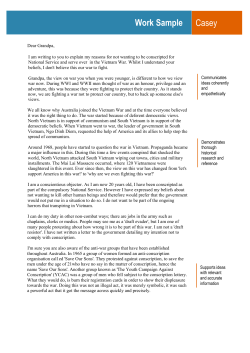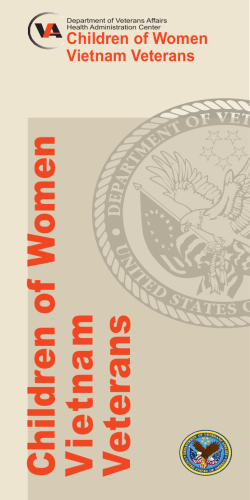
W Chapter 9 Vietnamization
Page 36 Chapter 9 Vietnamization W hile he was on the campaign trail in 1968, presidential candidate Richard Nixon claimed he had a 'secret plan' to end the Vietnam War. When the details of the plan were finally revealed in 1969, they turned out to be “the complete withdrawal of all U.S. combat ground forces, and their replacement by South Vietnamese forces on an orderly scheduled timetable.”21 What Richard Nixon proposed to do was to end the Vietnam War by turning the fighting over to the Vietnamese. While President Nixon ‘Vietnamized’ the war he secretly entered into negotiations with the North Vietnamese, and, also secretly, bombed suspected enemy bases in North and South Vietnam and even in Cambodia. In the course of four years these negotiations accompanied by ‘vietnamization’ and bombing resulted in a peace agreement that was supposed to allow free elections in the South. This chapter discusses President Nixon's vietnamization plan and the peace treaty he negotiated. After reading the chapter you will be asked to evaluate the plan and the treaty. President Nixon QuickTime™ and a TIFF (Uncompressed) decompressor are needed to see this picture. President Nixon How the U.S. 'Vietnamized' the Vietnam War The U.S. was not the first nation to try to vietnamize the Vietnam war. The French had tried it, but it did not work for them. President Eisenhower and Kennedy sent military advisors to teach the Vietnamese how to fight, but the South Vietnamese army never became an effective fighting force and U.S. troops were called in to save South Vietnam. So, what was Nixon going to do that would lead to a different outcome? One thing that Nixon did was to spend much more money to arm the South Vietnamese. He gave them the best guns, planes, artillery, etc. in the U.S. arsenal. He spent billions of dollars on rapid-fire machine guns, modern tanks, and the best M-16 rifles. He turned 1,200 airplanes and 600 helicopters over to the South Vietnamese, providing them the 4th biggest air force in the world. Nixon also spent a great deal of money training the South Vietnamese to fight. He brought their officers to the best military academies in the United States. Vietnamese soldiers were taught to use and repair their new weapons. They were trained to use napalm bombs, support ground troops with air cover, and conduct effective 'search and destroy' operations. U.S. units were withdrawn from Vietnam as South Vietnamese troops were pronounced ready to take over their combat positions. With U.S. participation in the war ever decreasing, President Nixon was spared the violent anti-war protests that disturbed Lyndon Johnson during his last years in office. The Vietnamization policy seemed to be working. President Nixon Expands the War to Cambodia In order to buy time for the South Vietnamese, President Nixon thought the U.S. should shut down enemy supply lines from North Vietnam. Supplies came to the Vietcong and the North Vietnamese army 21 http://www.tamu.edu/scom/pres/speeches/rmnvietnam.html Thomas Ladenburg, copyright, 1974, 1998, 2001, 2007 [email protected] Page 37 along a series of jungle paths through Laos and Cambodia known as the Ho Chi Minh trail. Enemy food and weapons would be stored in secret hideouts in Cambodia and brought into Vietnam when they were needed. Nixon therefore decided to bomb these trails and places where supplies were stored and to keep these raids a military secret. Even though it meant flying B-52's about 4,000 miles from bases in the Pacific, Nixon went ahead with these raids. These bombings, which were secret to the US public but not to the people targeted, were not effective. The bombs could not reach deep into underground supply bases dug by the Vietcong unless the B-52's were fortunate enough to score several hundred direct hits. On April 30, 1970, President Nixon escalated the war in Indochina even further by ordering U.S. troops to invade Cambodia. In addition to the supplies, Nixon hoped to find and destroy the North Vietnamese field headquarters. Nixon had the support of the military government of Cambodia, who the U.S. had encouraged to take control of their country from the once popular but ineffective leader, Prince Sihanouk. But the President did not have the support of the U.S. Congress nor the American people. Effects of the Invasion of Cambodia U.S. soldiers invading Cambodia succeeded in destroying hundreds of tons of enemy supplies but not the enemy headquarters which had been closed several weeks before the troops arrived. But this attack stirred up a hornet's nest of enraged demonstrators in the U.S. In Kent State, Ohio, protest lead to tragedy. On May 4, 1970 the National Guard fired on demonstrators, killing 4 and wounding 11 innocent bystanders. The longterm result of the invasion, was the downfall of the military government that had encouraged it. As a result, the Khmer Rouge, under the murderous dictator, Pol Pot, took control of Cambodia. Under his merciless regime, over one million Cambodians were put to death. Morning death of Jeffrey Miller at Kent State The invasion of Cambodia may have bought more time to train and arm the Vietnamese. But the real test for this army 22was what it could do in battle. The South Vietnamese Army in Laos On February 8, 1971, the Army of the Republic of (South) Vietnam began an attack on Laos. Its purpose was to break up concentrations of North Vietnamese troops, interrupt the flow of supplies from North Vietnam, and test how well the army could fight. As the ARVN entered Laos, North Vietnamese troops fell back as if in full retreat. But just at the incisive moment, the North Vietnamese sprung their trap and attacked South Vietnamese forces from three sides. The South Vietnamese immediately called for air cover, but the bombs intended for the North Vietnamese hit the troops they were called to protect. Pushing the panic button, South Vietnamese soldiers ran and called for helicopters to rescue them. When the whirly birds finally arrived, military discipline broke down completely. Fearing they would be left behind, South Vietnamese soldiers clawed one another trying to climb into the helicopters even if it meant just hanging on to its landing runners. As the helicopters barely cleared surrounding trees South 22 www.cris.com/~Mppa/ethics.html Thomas Ladenburg, copyright, 1974, 1998, 2001, 2007 [email protected] Page 38 Vietnamese soldiers were scraped off the runners and dropped to their death on the ground. It was a terrible scene — a military rout -- and a clue that Vietnamization was not working. The Peace Agreement of 1972 Under President Nixon, formal negotiations with the North Vietnamese began in January, 1969. In August of that year, foreign policy advisor Henry Kissinger had met secretly in Paris with his North Vietnamese counterpart. When they met again in February 1970, the talks were so secret that Nixon's Secretary of State, William Rogers, did not know they were being held. It was not until January 25, 1972 that President Nixon told the world that Kissinger had been secretly negotiating with the North Vietnamese. Little progress was made in the negotiations during the summer of 1972. In October, however, with presidential elections only a few weeks away, North Vietnam proposed an ‘in place’ cease fire, allowing North Vietnamese troops to remain in South Vietnam. In exchange the North Vietnamese dropped their insistence that the South Vietnamese government, still under President General Nguyen Thieu, be disbanded. Instead, the South and the North Vietnamese would arrange for a new government to supervise free elections which would determine the future of South Vietnam. Combined with other issues such as returning prisoners of war, the final treaty included the following, and in many ways resembled the 1954 Geneva Accords: 1. North Vietnamese, Vietcong, and South Vietnamese soldiers would stop fighting and hold on to all territory they occupied at the time of the cease-fire. 2. American troops would leave South Vietnam. 3. North Vietnamese troops could stay in South Vietnam 4. American Prisoners of War (POWs) would be returned while U.S. troops leave Vietnam. 5. The government of South Vietnam would allow a commission consisting of North and South Vietnamese to prepare for a democratic election. 6. The newly elected government would take over and run Vietnam. South Vietnam Opposes the Peace Treaty General Thieu had served as the chief executive officer of South Vietnam for seven years. He did not like the peace treaty that allowed a communist army of 145,000 soldiers and guerrillas to remain in South Vietnam while the United States completed its troop withdrawal. But Nixon got Thieu’s approval by making several concessions: He ordered bombings of Hanoi and Haiphong, the communist capital and port city. He turned more weapons over to Thieu and he wrote him a personal letter dated January 5, 1973 promising him more aid if needed, and warned him of dire consequences if he did not cooperate. The peace treaty ending U.S. participation in the Vietnam War was finally signed on January 27, 1973. The question we must ask ourselves — was the price too high; or was the treaty too favorable to the north. Thomas Ladenburg, copyright, 1974, 1998, 2001, 2007 [email protected] Page 39 Suggested Student Exercises: 1. Describe Nixon's Vietnam policy and then evaluate it considering these possibilities: a. Nixon expanded the war and continued the killing for four more years than necessary. b. Nixon did the right thing. The U.S. had to give President Thieu a chance to hold out against North Vietnam after the U.S. left. c. Nixon sold out the South Vietnamese. He should have stayed until all North Vietnamese troops left South Vietnam. Thomas Ladenburg, copyright, 1974, 1998, 2001, 2007 [email protected]
© Copyright 2026


















